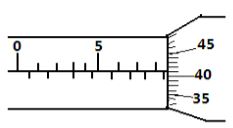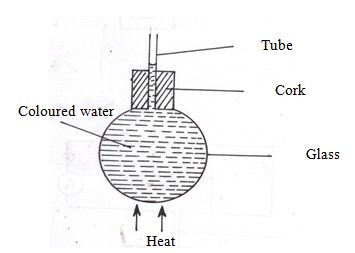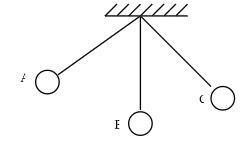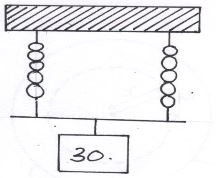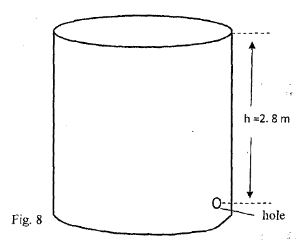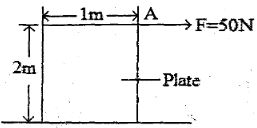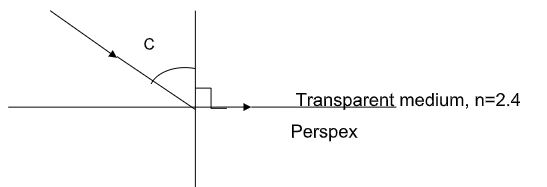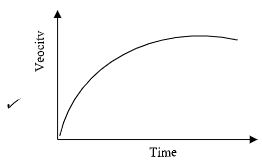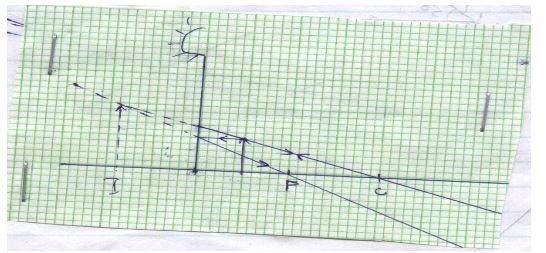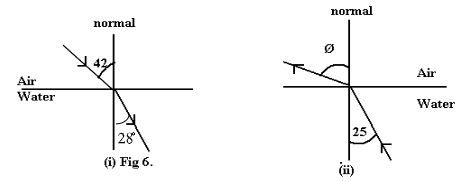SECTION A (25 MARKS) (Answer ALL the questions in the spaces provided)
- What is the reading on the micrometer screw gauge shown below with an error of
+0.5mm? (1mk) - In a ball and ring experiment, the ball goes through the rings at room temperature.When it is heated it does not go through the ring, but when left on the ring for some time, it goes through. Explain this observation (2mks)
- In the study of free fall, it is assumed that the force F acting on a given body of mass, m, is gravitational, given by F = ma. State two other forces that act on the same body (1mk)
- In the set up shown below, it is observed that the level of the water initially drops before starting to rise. Explain this observation (2mks)
- Distinguish between speed and velocity. (2mks)
- State how the pressure in a moving fluid varies with speed of the fluid. (1mk)
- A piece of metal weighs 3N in air and 2N when totally immersed in water. Calculate the volume of the metal (3mks)
- Explain how a person is able to drink a soda using a drinking straw. (2mks)
- Give a reason why air is not commonly used as the fluid in a hydraulic lift. (1mk)
- State one assumption made when estimating the size of an oil molecule in the oil drop experiment. (1mk)
- The figure below shows a swinging pendulum.
State the energy conservation taking place as the pendulum moves from A to B and B to C (2mks) - The identical springs of spring constant 3N/cm are used to support a load of 30N as shown.
Determine the extension on each spring (3mks) - In a vacuum flask, the walls enclosing the vacuum are silvered on the inside. State the reason for this. (1mk)
- State the features that govern the strength of a spiral spring of a given material. (2mks)
- Sketch velocity-time graph of a body moving down a viscous fluid. (1mk)
SECTION B (55 MARKS)
(Answer ALL the questions in the spaces provided)
-
- State the principle of conservation of linear momentum. (1mk)
- Calculate the recoil velocity of a gun of mass 0.4kg which fires a bullet of mass 0.0045kg at a velocity of 400ms -1 (3mks)
- State two factors which affect frictional force of a body (2mks)
- Suggest three ways in which friction can be minimized (3mks)
- State three advantages of friction (3mks)
-
- Fig. 8 shows a cylindrical can filled with a liquid of density 0.8 gcm -3 . A hole of diameter 2.0 cm is drilled at a depth of 2.8 m from the top of the can.
Determine:- The cross-sectional area of the hole. (2mks)
- The maximum pressure exerted by the liquid at the hole. (2mks)
- The maximum force exerted on a jet of liquid through the hole. (2mks)
- State the principle of moments (1mk)
- A metre rule whose centre of gravity is at the 50cm mark balances at the 35cm mark when a mass of 500g is placed at the 25cm mark as shown in the figure 8 below
- Determine the mass of the meter rule (3 mks)
- With the metre rule remaining on the knife-edge at the 30 cm mark, a mass of 125g is suspended from the 70 cm mark. The mass of 500g is moved until the rule is balanced. Determine the new position of the 500g mass (3 mks)
- Fig. 8 shows a cylindrical can filled with a liquid of density 0.8 gcm -3 . A hole of diameter 2.0 cm is drilled at a depth of 2.8 m from the top of the can.
-
- For a body moving with a constant acceleration, a , show that:
- V = u + at where v and u are the final and initial velocities respectively while t is the time taken (2mks)
- S = ut + ½at 2 where S is the distance covered (2mks)
- A car of mass 1200kg moving at 90km/h is brought to rest over a distance of 20m. Calculate the breaking force (3mks)
- An object is projected vertically upwards with a velocity of 200m/s. Calculate:
- Its velocity after 5 seconds (2mks)
- The distance covered in the first 8 seconds (2mks)
- The maximum height reached (2mks)
- The figure below shows a uniform cardboard in the shape of a parallelogram.
Locate the centre of gravity of the cardboard. (1 mk) - Two samples of bromine vapour are allowed to diffuse separately under different conditions, one in a vacuum and the other in air. State with reasons the conditions in which bromine diffuse slower. (2 mks)
- For a body moving with a constant acceleration, a , show that:
-
- State two factors affecting stability of body (2mks)
- The figure below shows a metal plate 2 m long, 1M wide and negligible thickness. A horizontal force of 50 N applied at point ‘A’ Just makes the plate tilt.
Calculate the weight of the plate. (3mks) - Fig 4 shows an image I formed by an object placed in front of a convex mirror. C is the centre of curvature of the mirror. Using ray diagram, locate the object position. (3mks)
- Fig 6 (i) and (ii) show refraction of light at air-water interface. Determine angle Ø in figure 6(ii) (3mks)
- A ray of light now travels through a transparent medium into the Perspex as shown in the figure below:
calculate the critical angle (3mks)
MARKING SCHEME
SECTION A (25 MARKS)
- What is the reading on the micrometer screw gauge shown below with an error of +0.5mm? (1mk)
M.S.R = 8.5 mm
Actual reading = 8.96 – 0.5 = 8.46mm
S.S.R = (0.01 × 46) = 0.46mm
= 8.96mm - In a ball and ring experiment, the ball goes through the rings at room temperature. When it is heated it does not go through the ring, but when left on the ring for some time, it goes through. Explain this observation (2mks)
The ball expands when heated and cannot go through the ring, but when left on the ring for sometime it heats the ring causing the ring to expand hence it passes through. - In the study of free fall, it is assumed that the force F acting on a given body of mass, m, is gravitational, given by F = ma. State two other forces that act on the same body (1mk)
Up thrust and frictional force - In the set up shown below, it is observed that the level of the water initially drops before starting to rise. Explain this observation (2mks)
Glass flask expands first, creating more volume for water. Water then expands increasing its level in the tube - Distinguish between speed and velocity. (2mks)
Speed is the distance covered per u nit time, while velocity of the sped is in a specified direction. - State how the pressure in a moving fluid varies with speed of the fluid. (1mk)
Pressure is inversely proportional to the speed/speed increases as pressure decreases - A piece of metal weighs 3N in air and 2N when totally immersed in water. Calculate the volume of the metal (3mks)
Up thrust = weight of water displaced by the metal
Wt of water displaced = wt in air – wt in water – (3 – 2) = 1N
Mass of water displaced = kg1/10 = 0.1kg
Density of water = 1000kgm-3
Vol. of the water displaced = 0.1/1000 = 0.001m3
Therefore vol. of metal = 0.001m3 - Explain how a person is able to drink a soda using a drinking straw. (2mks)
- He sucks the air in the straw reducing the pressure inside the straw 1mk. The greater atmospheric pressure outside pushes the liquid into the mouth 1mk.
- Give a reason why air is not commonly used as the fluid in a hydraulic lift. (1mk)
- Air is incompressible
- State one assumption made when estimating the size of an oil molecule in the oil drop experiment. (1mk)
- The oil drop is a perfect sphere
- The oil patch is circular
- The figure below shows a swinging pendulum.
State the energy conservation taking place as the pendulum moves from A to B and B to C (2mks)
- From A to B, potential energy changes to kinetic energy
- B to C, kinetic energy changes to potential energy
- The identical springs of spring constant 3N/cm are used to support a load of 30N as shown.
Determine the extension on each spring (3mks)
Each spring experiences a force of 30/2 = N15
F = ke e = F/k = 15/3 = 5cm
Each spring extends to 5cm - In a vacuum flask, the walls enclosing the vacuum are silvered on the inside. State the reason for this. (1mk)
- To reflect the outwards or inwards hence reduce heat loss by radiation
- State the features that govern the strength of a spiral spring of a given material. (2mks)
- Thickness of the wire
- Diameter of the coil
- Sketch velocity-time graph of a body moving down a viscous fluid. (1mk)
SECTION B (55 MARKS)
(Answer ALL the questions in the spaces provided)
-
- State the principle of conservation of linear momentum. (1mk)
For a system of colliding bodies, the total linear momentum remains constant provided no external forces act - Calculate the recoil velocity of a gun of mass 0.4kg which fires a bullet of mass 0.0045kg at a velocity of 400ms-1 (3mks)
Momentum of the bullet = m × v
= 0.004 × 400
= 1.8 kgms-1
Momentum before firing = momentum after firing
0 = 1.8 +0.4v
v = – 1.8/0.4
v = 4.5ms-1- State two factors which affect frictional force of a body (2mks)
Normal reaction
Nature of the surface in contact - Suggest three ways in which friction can be minimized (3mks)
By use of ball bearings
Lubrication by use of oils
Rollers - State three advantages of friction (3mks)
Enables one to walk
Enables the car to stop when breaks are applied
Lighting fire-matchstick lights because of its friction with the rough surface
- State two factors which affect frictional force of a body (2mks)
- State the principle of conservation of linear momentum. (1mk)
-
- Fig. 8 shows a cylindrical can filled with a liquid of density 0.8 gcm -3 . A hole of diameter 2.0 cm is drilled at a depth of 2.8 m from the top of the can.
Determine:- The cross-sectional area of the hole. (2mks)
A = πr2
= 3.142 x (2/200)2
= 3.142 x 10-4 m2 - The maximum pressure exerted by the liquid at the hole. (2mks)
p = hρg 1mk
= 2.8 x 0.8 x 1000 x 10
= 2.24 x 104 Pa 1mk - The maximum force exerted on a jet of liquid through the hole. (2mks)
F = P x A 1mk
= 2.24 x 10 4 x 3.142 x 10 - 4
= 7.0381N 1mk
- The cross-sectional area of the hole. (2mks)
- State the principle of moments (1mk)
When a body is in equilibrium, the sum of clockwise moments about a point is equal to the sum of anticlockwise moments about the same point - A metre rule whose centre of gravity is at the 50cm mark balances at the 35cm mark when a mass of 500g is placed at the 25cm mark as shown in the figure 8 below
- Determine the mass of the meter rule (3 mks)
Sum of anticlockwise moments = sum of clockwise moments
5 x 0.05 = M x 10 x 0.2
M = 0.25/2 = 0.125kg - With the metre rule remaining on the knife-edge at the 30 cm mark, a mass of 125g is suspended from the 70 cm mark. The mass of 500g is moved until the rule is balanced. Determine the new position of the 500g mass (3 mks)
1.25 x 0.2 + 1.25 x 0.4 = 5 x x
x = 0.75/5
0.15m or new position is at the 10 cm mark
- Determine the mass of the meter rule (3 mks)
- Fig. 8 shows a cylindrical can filled with a liquid of density 0.8 gcm -3 . A hole of diameter 2.0 cm is drilled at a depth of 2.8 m from the top of the can.
-
- For a body moving with a constant acceleration, a , show that:
- V = u + at where v and u are the final and initial velocities respectively while t is the time taken (2mks)
Acceleration is there when there is increase in velocity from u to v
a = v – u/t
at = v – u
V = u + at - S = ut + ½at2 where S is the distance covered (2mks)
Displacement = average velocity x time
S = u + v x t
2
but v = u + at
S =( u + u + at) x t
2
= ( 2u + at) x t
2
S = ut + ½ at2 - A car of mass 1200kg moving at 90km/h is brought to rest over a distance of 20m. Calculate the breaking force (3mks)
S = 20m u = 25m/s V = 0
V2 = M2 + 2as = V = 90 x 5/18
= 25m/s
O = 252 + 2 x 20 x a
625 = -40a
a= -15.625m/s2
F = M x a = 1200 x 15.625
= 18,750N
- V = u + at where v and u are the final and initial velocities respectively while t is the time taken (2mks)
- An object is projected vertically upwards with a velocity of 200m/s. Calculate:
- Its velocity after 5 seconds (2mks)
u = 200m/s, a = -g = -10ms-2
V = u – gt
= 200 – 10 x 5 = 200 – 50 = 150m/s - The distance covered in the first 8 seconds (2mks)
S = ut – ½ g t2
t = 2w x 8 – ½ x 10 x 82
= 1600 – 320
= 1280m - The maximum height reached (2mks)
V = 0, U= 200m/s
V2 = U2 – 2gH
O = 2002 – 2 x 10 x H
2002 = 20H
H = 200 x 20010 = 200M
20
- Its velocity after 5 seconds (2mks)
- The figure below shows a uniform cardboard in the shape of a parallelogram.
Locate the centre of gravity of the cardboard. (1mk) - Two samples of bromine vapour are allowed to diffuse separately under different conditions, one in a vacuum and the other in air. State with reasons the conditions in which bromine diffuse slower. (2mks)
Slower in air, as the air particles collide with bromine particles hence low rate of diffusion.
- For a body moving with a constant acceleration, a , show that:
-
- State two factors affecting stability of body (2mks)
Area of the Base Position of Centre of Gravity - The figure below shows a metal plate 2 m long, 1M wide and negligible thickness. A horizontal force of 50 N applied at point ‘A’ Just makes the plate tilt.
Calculate the weight of the plate. (3mks)
Taking moments about X;
Clockwise moments = Anticlockwise moments
2 x 50 = 0.5 x W
100 = 0.5W; W = = 200N - Fig 4 shows an image I formed by an object placed in front of a convex mirror. C is the Centre of curvature of the mirror. Using ray diagram, locate the object position. (3mks)
- Fig 6 (i) and (ii) show refraction of light at air-water interface. Determine angle Ø in figure 6(ii) (3mks)
Refractive index of water = 1.425 - A ray of light travels through a transparent medium into the Perspex as shown in the figure below:
Calculate the critical angle (3mks)
- State two factors affecting stability of body (2mks)
Download Physics Paper 1 Questions and Answers - Form 3 End Term 2 Exams 2023.
Tap Here to Download for 50/-
Get on WhatsApp for 50/-
Why download?
- ✔ To read offline at any time.
- ✔ To Print at your convenience
- ✔ Share Easily with Friends / Students

